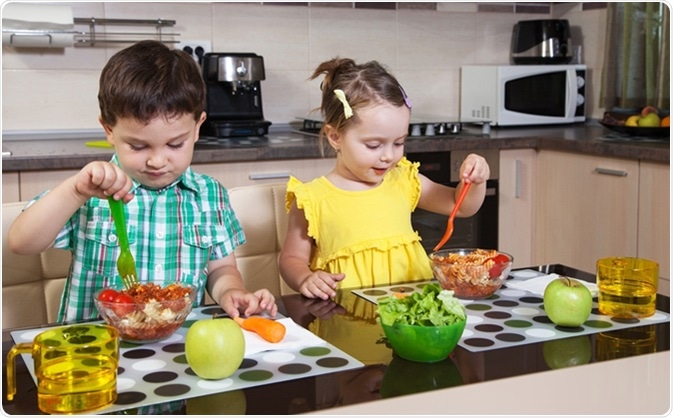
Nutritional Needs of Young Children (Age 5-10)
Children should be carefully fed so as to maintain and encourage good growth and meet their energy needs. Side by side, physical exercise should be promoted, as well as drinking plenty of plain water. The child should run and play outdoors for at least an hour every day, if possible.
Regular growth assessment is helpful in maintaining adequate dietary intake and physical growth.
Young children are extremely active, but eat little at a time. They should receive a lot of high-energy foods, such as carbohydrates in the form of whole-grain cereals, full-fat dairy or soy milk, vegetable oils, fruits (two servings) and vegetables in boiled, baked, steamed or sautéed form (three servings). A little butter is also helpful in adding energy for their needs.
Children between 5-10 years need about 1,500 to 2,000 kilocalories a day from their food.

Image Credit: GSerban / Shutterstock
Choosing Foods for Children
Foods for children should contain some from each of the five food groups, the amount depending on the age, physical growth and level of activity of the child.
- Vegetables: plenty of colored vegetables of different types, leafy and non-leafy– one serving is half a cup of cooked vegetables or legumes, and one cup of raw salad vegetables: 5-6 servings of fruits and vegetables should be offered every day
- Fruits of a variety of types – one serving is one medium piece or one cup of diced/canned fruit without sugar, two small fruits, such as plums, or an ounce of dry fruits
- Whole grains, as grains or flour, such as breads, pasta, oats and cereals – a serving being a bread slice/scone/muffin or half a cup of cooked cereal, pasta or rice: 4-6 servings a day
- Proteins, such as lean meat, poultry, eggs and fish, tofu, nuts and seeds, and legumes (peas, beans and pulses) – a serving is about 100 g raw meats/fish, two eggs, 170 g tofu, ¾ cup cooked legumes: 1-2 servings a day
- Milk/milk products including curds and cheese are excellent sources of healthy fat and protein – a single serving is 40 g cheese, a cup of milk or soy milk (the latter with added calcium), 200 g yogurt: 2-4 servings a day
- Fiber is excellent in helping to avoid constipation and promote a feeling of fullness, but too much is counterproductive
Plenty of water should be given to all children. Milk can be used as a contribution to morning and afternoon tea. Snacks should be appealing and nutritious, such as small amounts of freshly cut brightly colored vegetable sticks with delicious hummus or tomato ketchup (without added sugar or salt).
All food meant for children should be prepared and stored with excellent hygiene and flavor, without too much heat or spice.
Discretionary foods are to be added to the diet only on occasion and in small quantities. These include unnecessary sources of saturated fats, sugars and salt, such as cakes, desserts and processed foods.
How to Encourage Healthy Eating Habits
- Eating together as a family
- Enjoying foods from all these groups as often as possible to help children imitate the example of older siblings and parents
- Encouraging them to help select healthy colored fruits, vegetables, and healthy meats or other foods during grocery shopping
- Letting them help with food preparation especially from the vegetable and pulses group
- Preparing tasty soups and broths, which pack a lot of fiber and nutrition into a form that is easily edible and looks appealing
- Stocking fruits rather than fruit juice and chews, and cold water rather than soda or other sweetened drinks
- Starting the day off with a good breakfast
- Sharing interesting information about how foods are grown and how they reach the local market
- Encourage active outdoors play or work before or between meals for at least an hour a day
Vegetarian Diets for Children
A family with vegetarian tastes should take care to make sure the diet of children in the family is adequate to support physical and mental growth and development. It must provide sufficient energy, iron and other essential minerals and vitamins, to promote healthy bone and brain growth.
Fats from healthy sources must be present to enable the absorption of fat-soluble nutrients, such as vitamins A, E and D. Milk and milk products, or soy milk and soy products, should be a daily part of the diet, as should legumes.
Each meal should include a serving of lentils, nuts or other leguminous protein, such as baked beans, chickpeas, hummus, nut butters and curries. Pulses need to be cooked completely to facilitate good digestion and reduce bowel gas formation.
Reviewed by Dr. Jonas Wilson, MD, Ing. Med.
Sources
- www.betterhealth.vic.gov.au/.../vegetarian-diets-and-children
- https://www.cdc.gov/healthyschools/nutrition/facts.htm
- https://medlineplus.gov/ency/patientinstructions/000713.htm
- www.albertahealthservices.ca/.../...ving-for-your-5-to-11-year-old.pdf
- www.eatforhealth.gov.au/.../n55f_children_brochure.pdf
- https://www.nal.usda.gov/fnic/child-nutrition
- http://extensionpublications.unl.edu/assets/pdf/g1086.pdf
- www.nhs.uk/.../how-many-calories-do-children-need.aspx
Further Reading
Last Updated: Jun 25, 2018























.png)











No hay comentarios:
Publicar un comentario